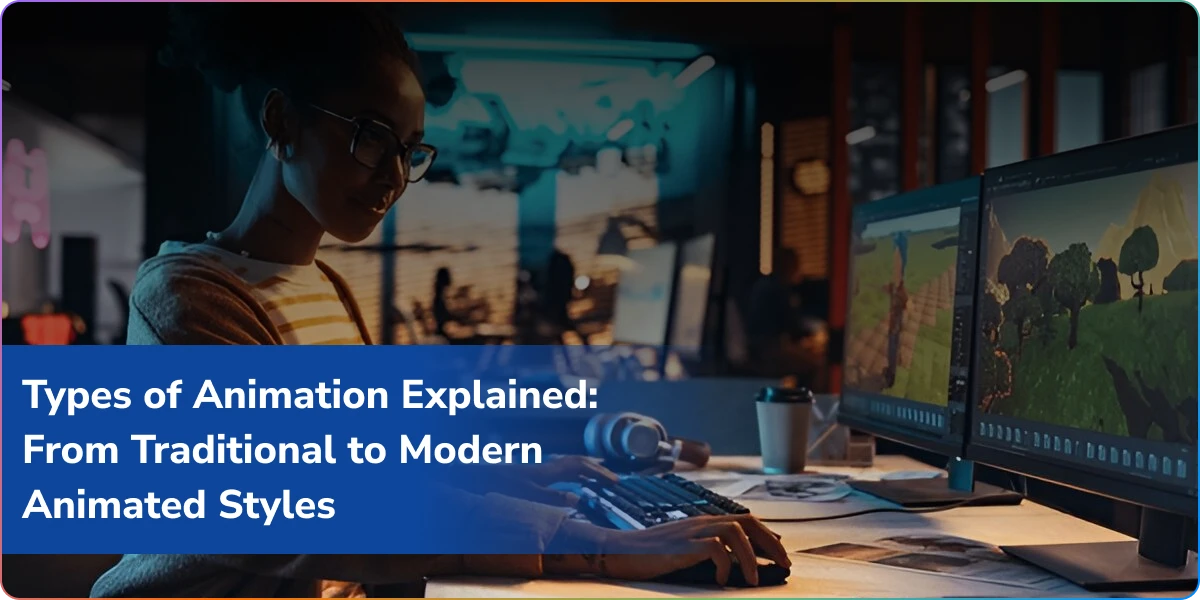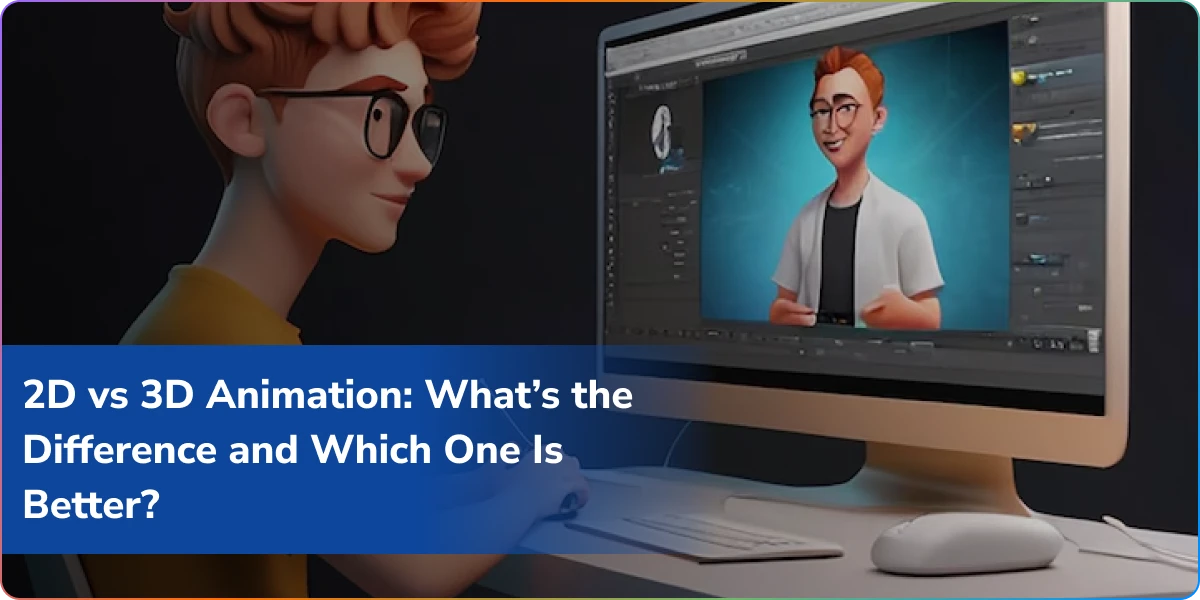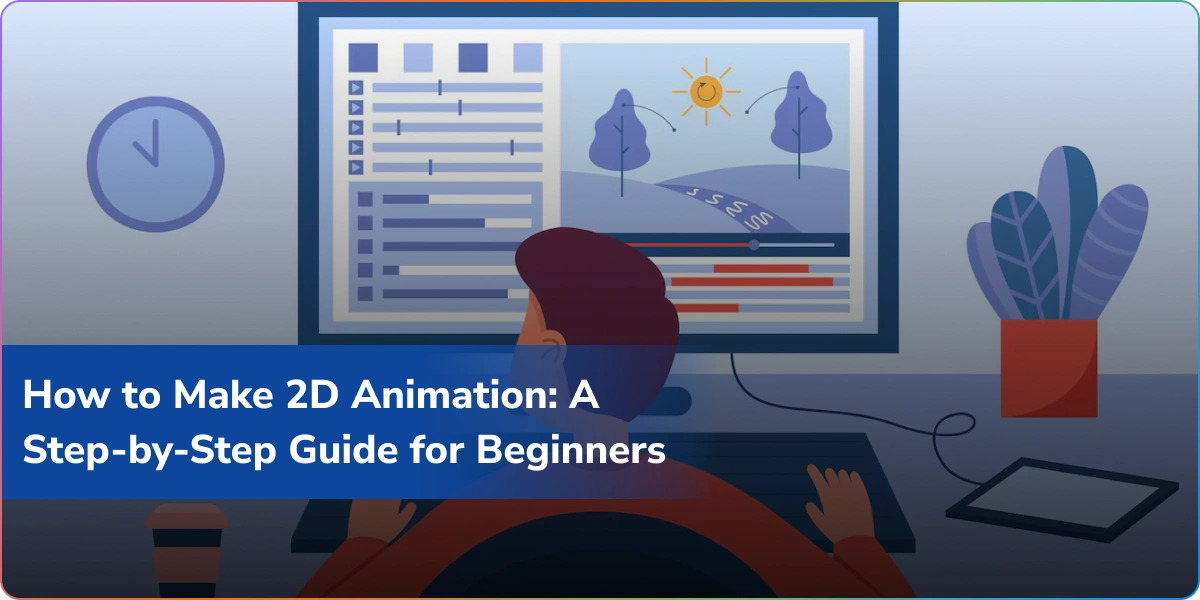Animation surrounds us, ranging from blockbuster films to smartphone games, from social media reels to online commercials. But have you ever stopped to consider the various methods that give those visuals life? In this blog, we will discuss the types of animation, define different styles of animation, and introduce you to how the art form has transformed from hand-drawn frames to state-of-the-art computer-generated imagery.
Whether you’re a keen learner, a business wanting to hire 2D animators, or a content creator looking for the best animation styles for your brand, this guide has it all.
What Is Animation
Animation is the art of making still photographs appear to be seen as moving by showing them in quick succession. Just like a flipbook, in which a sequence of drawings comes alive with movement and transformation.
Individuals tend to mix cartoons with animated content. A cartoon is a type (usually humorous and over-the-top), whereas animation is the way of producing moving images. In a nutshell, all cartoons are animated, but not everything that is animated is a cartoon.
Types of Animation
Traditional Animation (Hand-Drawn Animation)
One of the oldest and most cherished forms of animated styles, traditional animation consists of hand-drawing each frame by hand. Remember Disney’s Snow White and the Seven Dwarfs or The Lion King (1994). Artists draw thousands of frames by hand to illustrate smooth motion.
Pros:
- Timeless aesthetic appeal
- Engaging emotional connection
- Perfect for storytelling
Cons:
- Very time-consuming
- Expensive for large projects
Best For:
Movies, storybooks, educational films
2D Animation (Digital)
2D animation is the computer-based version of traditional animation. It entails making characters and settings in two dimensions with the help of software such as Adobe Animate, Toon Boom, or After Effects. You can move objects frame by frame or employ rigging principles.
Here you can get opportunities to hire 2D animators or search for 2D animators for hiring in case you are preparing a project. It’s convenient, cheaper than 3D, and perfect for explainer videos, mobile games, and web content.
Pros:
- Cheap and effective
- Easy to scale and edit
- Suitable for multiple platforms
Cons:
- Less realistic than 3D
- Can be flat due to a lack of layering
Best For:
Educational content, marketing videos, YouTube seriesWant 2D animators for hire? Connect with our expert animators to discuss your requirements today!
3D Animation
One of the most widespread in current media, 3D animation provides depth, realism, and dynamic movement to objects and characters. Pixar, DreamWorks, and Disney now almost exclusively use 3D animation to bring visually engaging worlds.
Artists model, rig, and animate using 3D software such as Blender, Maya, or Cinema 4D. The process is more technological but permits realistic storytelling and cinematic features.
Pros:
- High realism
- Immersive storytelling
- Dynamic camera angles and lighting
Cons:
- Longer production time
- Higher cost
Best For:
Feature films, gaming, simulations, commercials
Motion Graphics
Motion graphics combine visual design elements like typography, shapes, and logos with motion. Its inclination is more towards delivering information and less towards storytelling. One can find it in product demos, corporate videos, or data visualizations.
Pros:
- Visually neat and professional
- Best for branding and info-sharing
- Faster turnaround than character animation
Cons:
- Not suitable for emotional storytelling
- Limited character movement
Best For:
Marketing videos, app demos, infographics
Stop Motion Animation
Physical objects are slowly moved between frames when photographed in stop motion. The result is realistic motion when played back. Subtypes are claymation (such as Wallace & Gromit), puppet animation, and cut-out animation.
Every object or character has to be adjusted for every frame, so it’s very time-consuming but extremely artistic.
- Unique tactile aesthetic
- Quirky and charming visual style
- Laborious and time-consuming
- Prone to human error
Best For:
Indie films, children’s content, innovative ads
Cut-Out Animation
A classic stop motion technique, this uses flat figures, props, and backgrounds cut out from paper or fabric. It is easy to look at, but in the right hands, it can be very expressive.
Digital cut-out animation (e.g., South Park) takes the idea into the computer age, using software to mimic the same look without physical materials.
Pros:
- Cost-effective
- Stylized visuals
Cons:
- Limited motion
- Needs good design skills
Best For:
Satirical programs, educational films
Rotoscoping
Rotoscoping is tracing over actual-life footage, frame by frame, in order to create life-like animations. It can be applied to special effects or stylized sequences (consider A-ha’s Take On Me music video or Waking Life).
Pros:
- Natural and smooth motion
- Ideal for combining live-action and animation
Cons:
- Time-consuming
- Demands high attention to detail
Best Used For:
Music videos, sci-fi effects, stylized films
Experimental Animation
Among the different types of animation, this one doesn’t follow the standard norms. It often breaks away from traditional storytelling and explores animation as an art form. One can find it in museums, galleries, and indie film festivals.
Pros:
- Limitless creative freedom
- Expresses complex or abstract ideas
Cons:
- Difficult to be widely understood
- Lesser commercial use
Best For:
Art installations, avant-garde film, music videos
Choosing the Appropriate Style for Your Project
With all the varied types of animation, how do you pick the best one for your project? Here are a few tips:
- Purpose: Want to educate? Pick 2D or motion graphics. Want to tell an emotional story? Pick 3D or traditional.
- Budget: 2D and motion graphics are budget-friendly. 3D and stop motion are resource-hungry.
- Platform: For web or mobile apps, 2D animation is light and flexible.
- Timeline: Short deadlines? Motion graphics or cut-out style suits best.
Require expert assistance? You always have the option of hiring 2D animators or the entire animation crew, depending on the scope and cost of your campaign.
Animation Techniques to Learn
No matter what style, animators employ several animation techniques to make the visuals come alive. Some of these essentials are:
- Frame-by-frame animation: Drawing each frame individually for the most fluidity.
- Tweening: Computer software creates the middle frames automatically between two images.
- Rigging: Building a digital skeleton of a character to make it easier to move around.
- Keyframing: Placing marks on the beginning and end of movement.
- Onion Skinning: Looking at several frames simultaneously to orchestrate motion smoothly.
Learning these animation techniques will assist you in talking to your animation team better and having your vision interpreted properly.
Why Animation Matters in 2025 and Beyond
In this digital-first world, companies and creators cannot overlook the impact of animation. From app tutorials to product explainers and social reels to cinematic trailers, animated styles are able to grab attention and communicate in an effective manner.
Moreover, the need for specialist jobs like 2D animators for hire is increasing, courtesy of industries such as e-learning, healthcare, fintech, and gaming going gaga over animated content more than ever before.
Conclusion
From the classic hand-drawn frames to today’s 3D and digital styles, there’s a style of animation that adds its own touch to storytelling. Whether you’re a storyteller or a viewer, knowing the different styles will make you appreciate the art and select the proper animation for your purpose. Animation just keeps getting better—melding art, technology, and imagination like never before.
If you’re a startup or an organization looking to hire animators skilled in 2D, 3D animation, and other visual media, look no further, as we at Logixbuilt Solutions avail expert animators for hire as well as take up challenging projects and deliver outstanding results in the given timeframe. Connect with us today & let us discuss your project right away!
FAQs
1. What are the main types of animation?
Traditional, 2D, 3D, stop motion, motion graphics, rotoscoping, and experimental animation.
2. What is the difference between cartoon vs. animated content?
Cartoon is a genre or style, usually humorous. Animation is the technique employed to animate visuals.
3. Which animation is most suitable for marketing videos?
Motion graphics or 2D animation is best because of their clarity, cost-effectiveness, and versatility.
4. Where do I get good 2D animators for hire?
Search for agencies like ours – Logixbuilt Solutions, or platforms with portfolios, customer reviews, and experience in your desired style.
5. Is traditional animation still used?
Yes, particularly in art movies, retro productions, and for its distinct appeal.


